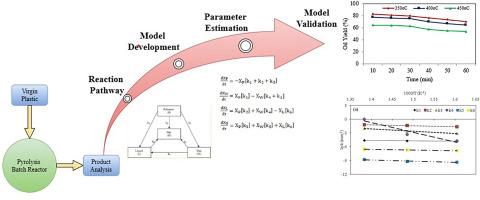聚烯烃升级回收的实验研究及集总动力学建模研究
IF 3.4
4区 化学
Q2 CHEMISTRY, MULTIDISCIPLINARY
引用次数: 0
摘要
本文采用复杂的集总模型对聚丙烯(PP)、高密度聚乙烯(HDPE)和低密度聚乙烯(LDPE)的热解动力学进行了比较分析。与以往许多专注于单聚合物动力学模型或采用简化反应方案的研究不同,本研究开发了一种增强的多步反应网络,明确考虑了初级分解和次级裂解途径,从而提高了产品分布预测的准确性。通过将详细的反应框架与MATLAB中使用LSQNONLIN和ODE45求解器的鲁棒非线性回归方法相结合,研究获得了比传统曲线拟合方法更高的动力学参数估计精度。结果表明,HDPE表现出最高的活化能(222.97 kJ mol−1),表明其热稳定性优于LDPE (193.44 kJ mol−1)和PP (62.16 kJ mol−1)。本工作的亮点之一是发现较低的热解温度(400°C)通过减少二次裂解而达到最佳产液率,这符合可持续燃料生产原则。该研究还强调了先前集总模型的局限性,即忽略了蜡分解途径,而蜡分解途径对于优化油气分布至关重要。未来的研究应探讨催化干预和反应器设计的改进,以提高产品的选择性和可扩展性。本研究提供了一个更全面的动力学框架,以促进塑料废物通过热解的增值,帮助开发有效的废物转化为燃料的策略。本文章由计算机程序翻译,如有差异,请以英文原文为准。

Experimental investigation and lumped kinetic modeling studies for upcycling of polyolefins
The present work discusses on comparative kinetic analysis of the pyrolysis of polypropylene (PP), high-density polyethylene (HDPE), and low-density polyethylene (LDPE) using sophisticated lumped models. Unlike many previous studies that focused on single-polymer kinetic models or employed simplified reaction schemes, this study develops an enhanced multistep reaction network that explicitly considers both primary decomposition and secondary cracking pathways, thereby improving the accuracy of product distribution predictions. By integrating this detailed reaction framework with a robust nonlinear regression approach using LSQNONLIN and ODE45 solvers in MATLAB, the study achieved greater accuracy in estimating kinetic parameters than traditional curve-fitting methods. The findings reveal that HDPE exhibits the highest activation energy (222.97 kJ mol−1), indicating it is more thermally stable than LDPE (193.44 kJ mol−1) and PP (62.16 kJ mol−1). One of the highlights of the present work is that lower pyrolysis temperature (400 °C) is found to be optimum for liquid yield by reducing secondary cracking, which aligns with the sustainable fuel production principles. The study also emphasizes on the limitations of previous lumped models that overlooked wax decomposition pathways, which are crucial for optimizing the hydrocarbon distribution. Future research should investigate catalytic interventions and reactor design modifications to enhance the product selectivity and scalability. This study offers a more comprehensive kinetic framework for advancing the valorization of plastic waste through pyrolysis, aiding the development of efficient waste-to-fuel conversion strategies.
求助全文
通过发布文献求助,成功后即可免费获取论文全文。
去求助
来源期刊
CiteScore
3.50
自引率
7.70%
发文量
492
审稿时长
3-8 weeks
期刊介绍:
The Journal of the Indian Chemical Society publishes original, fundamental, theorical, experimental research work of highest quality in all areas of chemistry, biochemistry, medicinal chemistry, electrochemistry, agrochemistry, chemical engineering and technology, food chemistry, environmental chemistry, etc.

 求助内容:
求助内容: 应助结果提醒方式:
应助结果提醒方式:


